28 Types of Purple Fruits (With Pictures) – Identification Guide
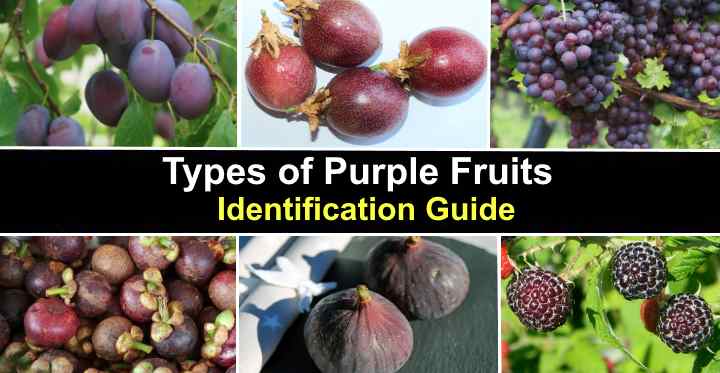
Purple fruits come in a variety of shapes, sizes, and flavors. From common fruits like plums and figs to purple berries and tropical fruits, there is a wide range of purple fruits to choose from. Common types of purple fruits include grapes, blueberries, passion fruit, and damson plums. These fruits add a pop of color to your plate and are packed with vitamins and antioxidants.
Purple fruits are exceedingly healthy foods, and their vibrant colors make them stand out on the plate. They can be pomes, drupes, pepos, and berries. Also, consuming various types of fruits with purple flesh or skin helps contribute toward a healthy, varied diet.
This article explores different types of purple fruits, their unique qualities, and their distinct characteristics.
What Are Purple Fruits?
Purple fruits fall into four main categories—berries, pomes, drupes, and pepo. For example, plums are a type of drupe, with a single stone surrounded by a thick, juicy, fleshy layer and purple skin. However, mulberries, chokeberries, gooseberries, and purple raspberries are small, round purple fruits without a stone.
Although citrus fruits are also a type of fruit, there are no purple citrus fruits. The closest may be blood oranges with dark reddish, almost purple flesh.
Here are brief descriptions of types of purple fruits:
Drupes: Fruits with a single seed surrounded by a pericarp. The pericarp consists of a hard shell (endocarp), fleshy layer (mesocarp), and skin (exocarp). Examples are plums and cherries.
Pomes: The purple fruits are characterized by a central core with one or more seeds. An unusual type of pome is a purple apple.
Pepo fruits: These purple fruits are modified berries featuring a tough outer rind enveloping juicy flesh. A delicious type of purple pepo fruit is passion fruit.
Berries: Purple berries include grapes, bilberries, gooseberries, and blueberries. True berries are simple fruits that develop from one flower. These fruits have pulpy flesh with no noticeable stones or pits.
Some types of purple fruits are called berries, although they are not berries in the botanical sense. For example, raspberries and mulberries are classified as aggregate fruits from a single flower with more than one ovary.
Why Are Some Fruits Purple?
Some fruits have purple to black flesh or skin due to anthocyanins—powerful antioxidants that provide various health benefits. These compounds, prevalent in berries, grapes, and plums, not only contribute to the fruits’ vibrant color. According to scientists, purple fruits offer excellent nutritional value and many benefits for cardiovascular health and health in general.
Types of Purple Fruits
Let’s look at some purple fruits in detail, including drupes, berries, and pepo. These delicious, juicy fruits have either purple flesh or purple skin. Depending on the climate, you can grow many of the common purple fruits in your garden. Other exotic purple fruits are only found in specialist stores.
Passion Fruit (Passiflora edulis)
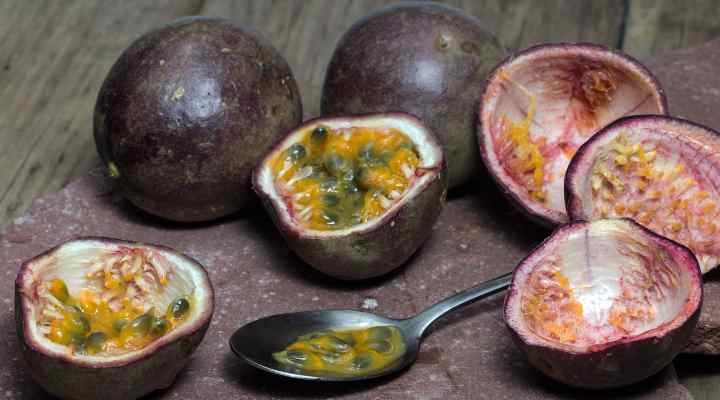
Passion fruit is a tropical purple fruit, highly prized for its unique flavor and vibrant appearance. This purple vine fruit is a type of pepo characterized by its round or oval shape and thick, smooth purple skin. The fleshy purple fruit has pulpy juice and up to 250 brown seeds.
Purple passion fruit has an intensely sweet and tangy flavor. It is often described as combining tropical fruits like pineapple, mango, and citrus. You can scoop out the pulp and enjoy it on its own. Or the purple fruit adds a refreshing, tropical twist to desserts, ice creams, yogurt, or fruit juices.
Passion fruit grows on a perennial, purple-flowering vine. The fruits are round or egg-shaped and measure 1.6” to 3” (4 – 7.5 cm) in diameter. Passion fruit is classed as a type of berry called a pepo. Passion fruit is native to South America, with purple and yellow varieties.
Plum (Prunus domestica)

Plums are a variety of delicious stone fruits (drupes), many of which have deep purple skins. Purple plums are typically round or oval, with smooth skin surrounding sweet, juicy yellow flesh. Plums have a rich, sweet-tart flavor that adds a refreshing twist to the fruit. The tartness depends on the plum variety.
Plums have high nutritional value and, like many purple fruits, are a good source of vitamins and minerals. These include vitamins C and K, potassium, dietary fiber, and antioxidants. You can consume plums fresh or use them to bake pies, tarts, pudding, and cakes. Dried plums are called prunes.
Purple plums are typically oval or spherical and can measure up to 3” (7.5 cm) across. They consist of a single seed surrounded by a pericarp. Ripe plums should be firm but slightly soft to the touch. Under ripe plums can be exceedingly tart and unpalatable. Some varieties of sour purple plums require cooking with sugar.
Damson Plum (Prunus domestica subsp. insititia)
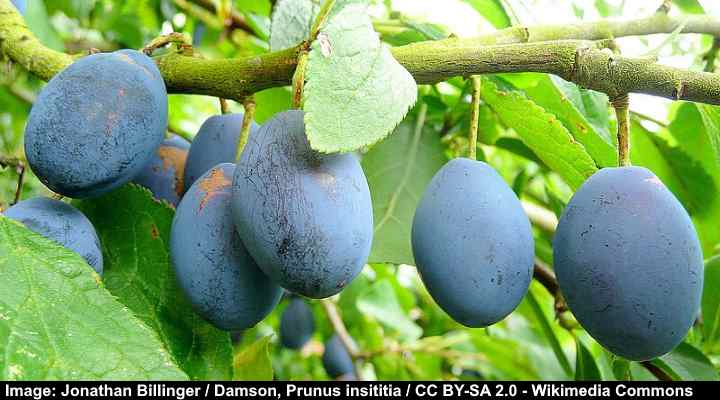
Damson plums are a type of sour purple plum commonly used to make jams and jellies. The small, oval, blue-purple stone fruits have a sharp taste that combines bitter and sweet notes. A distinctive feature of the plum is its yellow flesh with high sugar content and astringent taste.
Damson plums are typically smaller than other varieties of plums. They are characterized by dark purple or black skin with a bluish-waxy coating. The plums are egg-shaped or slightly oblong. The fruit’s center is a hard stone surrounded by yellow-green flesh that tastes tangy.
Damson plum trees are small to medium-sized trees that grow up to 15 ft. (4.5 m meters) tall. This tart plum ripens in the fall; however, it takes several years for the small fruit tree to produce its purple fruit. Due to its sharp taste, damson plums are commonly used in baking or making jams, compotes, and chutneys rather than eating raw.
Purple Apples (Malus)
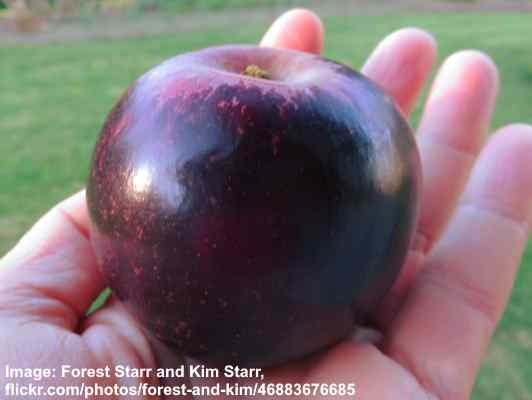
Purple apples are some of the most unusual pome fruits you can come across. The skin of these strange purple fruits is deep purple shades surrounding crisp white flesh. Purple apples have yellow speckles when ripe, adding to their unusual appearance. They have a sweet, slightly acidic taste.
Here are three types of purple apples:
Malus ‘Bravo’: The best variety of purple apple is the ‘Bravo’ cultivar. This type of apple is common in Australia, and the fruits have a purple to burgundy skin.
Malus ‘Purple Mountain Majesty’: This apple cultivar has purple skin that is as deep as purple plums. It has tender, white flesh.
Malus ‘Black Diamond Apple’: Native to China, this purple fruit has deep purple, almost black skin surrounding crispy white flesh. The rare fruits cost over $7 (USD) each and are difficult to find even in specialty grocery stores.
Teinturier Grape (Vitis vinifera ‘Purpurea’)
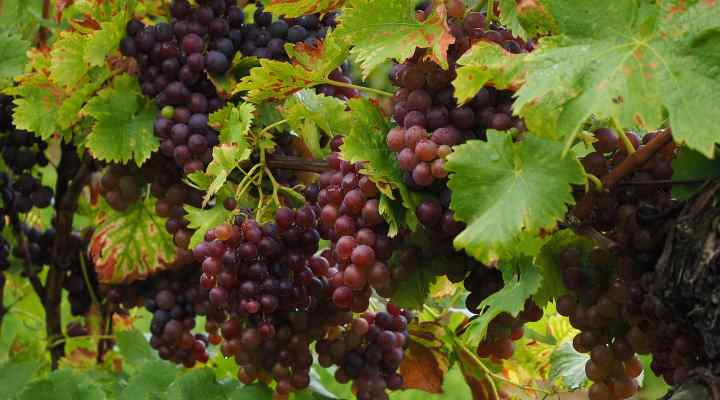
Purple grapes are delicious berries growing in large, dangling clusters from climbing vines. The deep purple-reddish grapes contrast nicely with deeply lobed leaves that change from green to burgundy throughout summer. The purple grapes have a sweet reddish flesh surrounded by bitter skins.
Besides the delicious round purple fruits, Vitis vinifera ‘Purpurea’ has tremendous ornamental value in gardens. The cold-hardy deciduous climber can cover arbors, pergolas, or unsightly fences. Its large leaves create a privacy screen in summer and fall. As the season progresses, the foliage becomes fiery crimson-red, adding a pop of color to gardens.
Also called Teinturier grapes, the purple fruits are delicious for snacking due to their sweet yet tangy taste. The purplish-red berries are also a variety of grapes used for making red wine. They are unusual purple fruits because most red grapes have yellowish flesh—Teinturier grapes have red flesh.
Concord Grape (Vitis labrusca ‘Concord’)
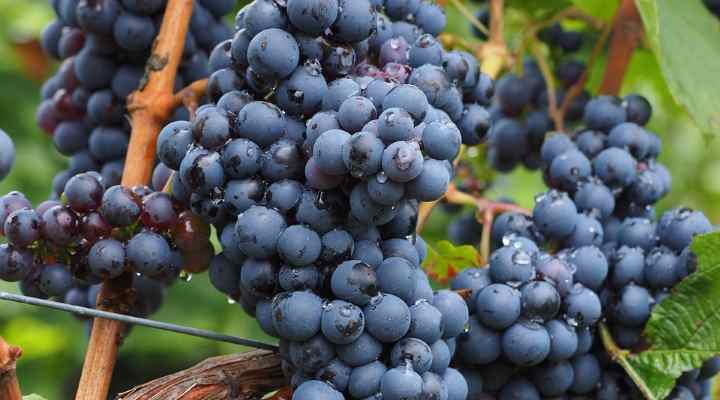
Concord grapes are known for their purple to blue-black color and sweet flavor. The delicious purple grapes grow in mid-sized clusters on slimming shrubs or vines. They have a thick skin that easily separates from the juicy flesh inside. The flesh is typically sweet and slightly tart, providing a burst of flavor with each bite.
Native to North America, concord grapes are ideal for making grape juice, red wine, jellies, and jams. The purplish fruits have decorative value as they contrast nicely with three-lobed green leaves that turn gold and orange shades in the fall. The juicy fruits are cold-hard to USDA Zone 4, making them ideal for northern gardens.
Also called fox grapes, the vining plant is a good landscaping solution to add height to gardens. The twining stems provide beautiful cover for arbors, fences, walls, or trellises.
Fig (Ficus carica)

Fig is an egg-shaped purple fruit that grows on large trees or shrubs. The unusual fruit’s flesh consists of tiny flowers blooming inside a cup-like structure. The succulent, fragrant purple fruits measure 1” to 2” (2.5 – 5 cm) long. The flesh of the fig is juicy and succulent, with hundreds of tiny seeds scattered throughout when ripe.
Figs are a type of false fruit with a flesh structure called a syconium. Botanically, this is a cluster of unique inverted flowers that turn into a ‘multiple fruit.’ They are typically green when unripe and turn a deep purple or brownish color when fully mature.
The flesh of a fig is juicy and succulent. It boasts a luscious honey taste with a delicate blend of sweetness and subtle earthiness. The fruit’s texture is tender and chewy, featuring a smooth exterior that encases tiny seeds. The fig’s succulent and slightly grainy interior creates a uniquely satisfying eating experience.
Purple Mangosteen (Garcinia mangostana)
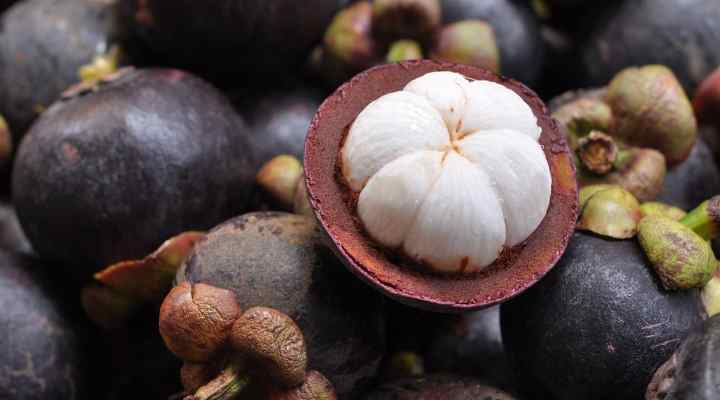
Purple mangosteen is an unusual purple fruit due to its tough purple outer layer and bright white segmented flesh. It’s a tropical fruit that is native to Southeast Asia. The fruit’s white flesh consists of fibrous, fluid-filled vesicles shaped like garlic cloves. The purple fruit measures 2.5” to 3” (6 – 7.5 cm) in diameter.
Opening the purple rind of mangosteen fruits reveals triangular segments arranged like a tangerine. Each segment has a seed, like an almond. The white flesh is exceptionally sweet and has a tropical taste, like peach and pineapple. It also has some acidity, making it refreshing to eat.
The best way to eat purple mangosteens is fresh by scooping out the flesh with a spoon. You can add white fruit segments to fruit salads, desserts, and smoothies. Mangosteen rind is not edible and is usually discarded.
Purple Guava (Psidium guajava)
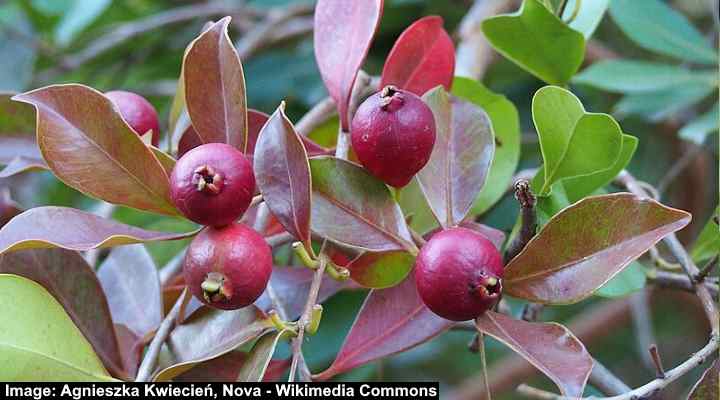
Purple guava is a tropical fruit with vibrant purple-colored skin and pink to purple flesh. It’s a small to medium-sized fruit growing 2” to 4” (5 – 10 cm) in diameter. It has sweet and tangy flesh, tasting similar to a mix of strawberry, pear, and pineapples.
Inside the purple guava is pinkish-purple pulp filled with small, edible seeds. You can scoop out the flesh and consume it raw. Or you can use the tropical fruit to make juices, smoothies, jams, jellies, and desserts. Purple guavas are typically harvested when fully ripe to ensure the best flavor and texture.
Purple guava also goes by the names red cattley guava, red cherry guava, or red strawberry guava. The purplish-red fruits ripen in late spring and mid-summer. You can tell when guava fruit is ripe because the inside is tender and tastes juicy, not dense and crunchy.
Another variety of the purple fruit is the purple forest guava (Psidium eugeniaefolia). It’s a round to pear-shaped fruit with glossy purple skin surrounding bright green or creamy-white flesh. The purple fruit grows on shrub-like trees, measuring up to 1.4” (3.5 cm) in diameter.
Purple Raspberry (Rubus occidentalis)
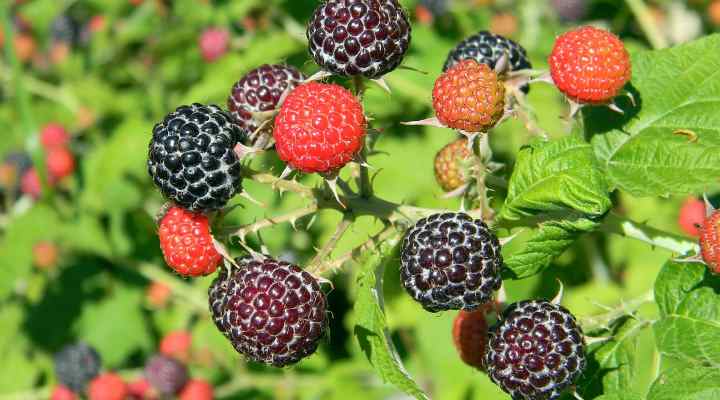
Raspberry cultivars ‘Brandywine,’ ‘Royalty,’ and ‘Estate’ hybrids are types of accessory fruits with a deep purple color. The purple fruits have a rich, juicy texture and a complex flavor profile that is sweet and slightly tangy. Unlike traditional bright red raspberries, purple raspberries have a darker, almost black hue.
Purple raspberries look like red raspberries, with their deep purple color setting them apart. They also have berry-like fruit that easily detaches from the carpel. Purple raspberry seeds are smaller and softer than red raspberries, making them more enjoyable to eat. They also have a sweeter, less tart flavor than red raspberries.
You can enjoy purple raspberries fresh, eaten straight from the shrub. Their sweet taste makes them ideal for culinary applications like baking, desserts, jams, and jellies. Additionally, their vibrancy adds a pop of color to garnish or decorate dishes.
Purple Star Apple (Chrysophyllum cainito)
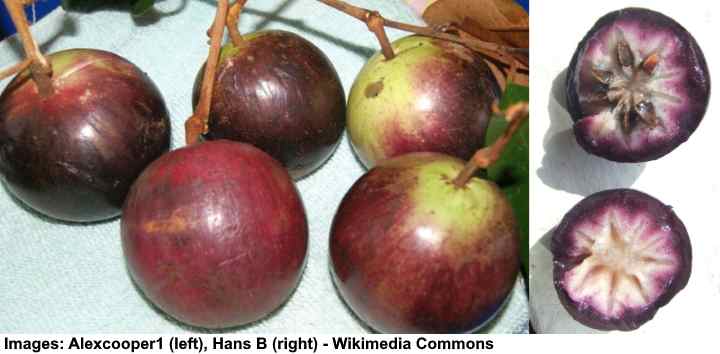
Purple star apple is a tropical, purple-skinned round fruit growing up to 3” (7.5 cm) in diameter. Native to the Caribbean and Central America, the fast-growing fruit has a purple and white center with a distinctive star-shaped pattern when sliced through the center. Its vibrant purple or dark reddish exterior has a shiny surface.
Purple star apples have a sweet and juicy flesh ranging from white to light purple when ripe. The texture is creamy and smooth, similar to ripe avocados. The taste is often described as a combination of tropical fruits and grapes. Its leathery, purple skin is inedible.
After removing the seeds, you can eat the flesh of purple star apples fresh. Culinary uses for these tropical purple fruits include incorporating them into fruit salads, desserts, and smoothies. Its tropical taste also goes well with citrus fruits.
Purple Sugar Apple (Annona squamosa)

The tree of the purple sugar apple is native to South America, and the purple fruit is grown in most tropical and subtropical regions of the world. The fruit is round or conical and is 6–10 cm (2.3–4″) long. Purple sugar apples are eaten fresh, and are loaded with vitamins, minerals, antioxidants and fiber.
The purple sugar apple tree produces an edible sweet and juicy fruit that is covered with a thick and hard scaly purple skin. Also called sweetsop, the taste of the purple fruit is described as custardy and creamy, like banana and pineapple. The flesh of the purple sugar apple is pale creamy-yellow, with inedible black seeds.
Sugar apples have various cultivars and varieties that have green or purple rinds. Cultivars with purple skin incluse ‘Thai purple’ and ‘Kampong Mauve’.
Purple Dragon Fruit (Hylocereus polyrhizus or Selenicereus costaricensis)
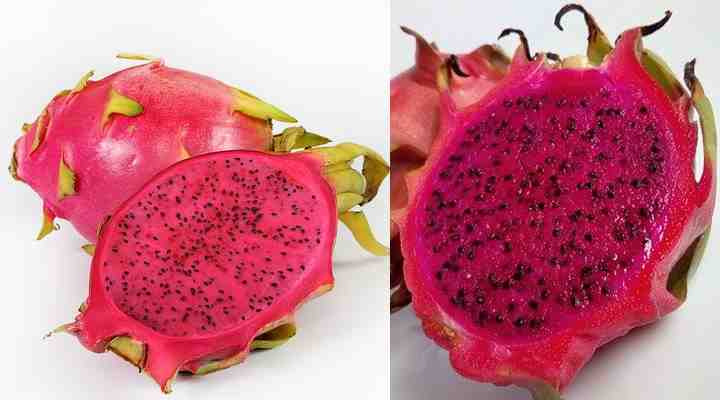
Red Dragon Fruit – Pitaya
Purple dragon fruit is a vibrant magenta or deep purple, exotic fruit with a striking appearance and unique taste. The tropical pinkish-purple fruit has thick, leathery skin and green spiky scales. The fruit is soft and juicy, deep magenta or purple flesh studded with numerous small black seeds.
The texture of the purple dragon fruit is like a kiwi—slightly grainy with a smooth consistency. It tastes mildly sweet, with a subtle hint of citrus and pear, giving it a refreshing, tropical flavor. The magenta-purple fruit is typically pear-shaped and grows on impressive ornamental vines.
Purple dragon fruit is not only delicious but also packed with nutrition. It is rich in vitamins B and C, dietary fiber, and micronutrients. Also, compared to white-fleshed dragon fruits, purple dragon fruit has higher antioxidant levels.
You can enjoy purple dragon fruit by cutting it in half and scooping out the flesh with a spoon. You can also eat the skin or peel of dragon fruit if you wash it carefully first. The juicy flesh adds vibrancy and tropical flavor to smoothies, juices, and desserts.
Red Mulberry (Morus rubra)
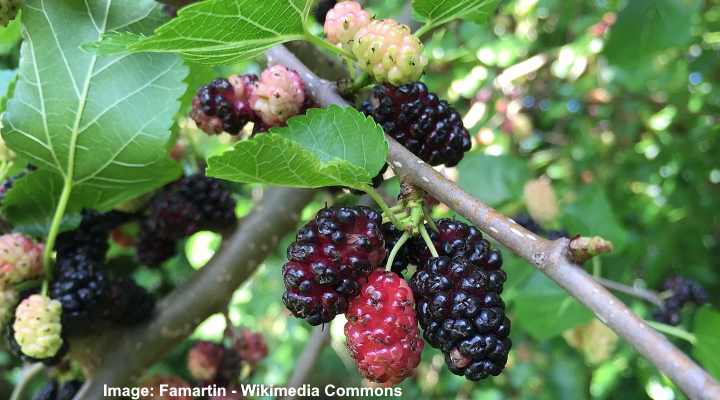
Red mulberries are dark purple-reddish fruits that look like large blackberries. These sweet, juicy berries grow on deciduous trees and measure 1” (2.5 cm) in diameter. When ripe, the fruits are dark purple, almost black, and have a rich, sweet flavor like a combination of blackberries and raspberries.
Individual red mulberries are a cluster of small drupes with a flavor like their black mulberries and better tasting than white mulberries. The dark-colored juice from the fruit can easily stain your fingers and clothing due to their dark color.
The delicious, fruity taste of red mulberries makes them an ideal ingredient for adding to juices, smoothies, or various baked goods such as pies, tarts, and jams. They are also delicious and nutritious toppings for cereal or yogurt. Of course, you can eat them fresh straight off the tree.
Purple Chokeberry (Aronia prunifolia)
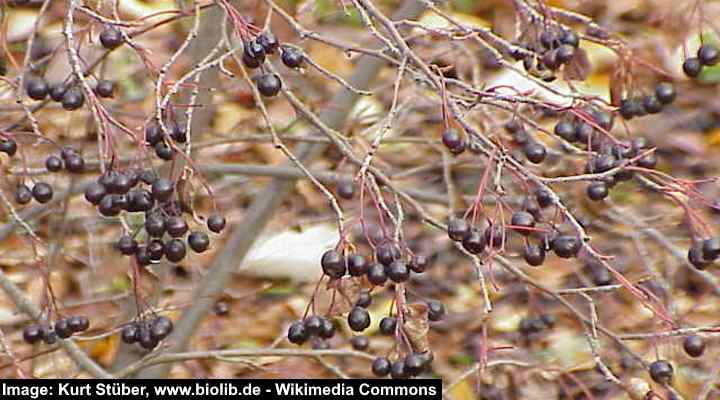
Purple chokeberry is a type of dark purple fruit with a tart, highly astringent taste. Mature chokeberries are dark purple or blackish-purple and measure 0.33” (0.84 cm) in diameter. The tart drupes mature by fall and persist through winter. The purple fruit’s astringency makes your mouth feel dry.
Purple chokeberry shrubs have grayish-silvery elliptical leaves up to 3” (7.5 cm) long. The foliage turns eye-catching red, burgundy, and purple shades in the fall, complementing the glossy purple fruits.
Due to their exceedingly tart taste, people rarely eat the fruits raw. Some say they are so tart that eating them in large quantities can induce choking—hence the name. Instead, chokeberries are ideal for sweetening to make nutritious jams, jellies, and syrups. Additionally, dried chokeberries are delicious in smoothies for a nutritional boost.
Purple Gooseberry (Ribes uva-crispa)

Gooseberries are a type of berry in the currant family that grows on small bushes. Purple varieties of gooseberry fruits have smooth, reddish, or deep purple translucent skin. They have a distinctive tart flavor, combining sweetness with a slight acidity. The purple berries have a firm texture and typically contain small seeds.
Purple gooseberries are small fruits about the size of small grapes. They grow in summer in clusters of two or three berries. As the name suggests, gooseberries have a purple hue when fully ripe. When eaten fresh off the bush, purple gooseberries have a sweet, tangy, refreshing flavor. The oval berries are popular for making jams, jellies, and other sweet treats.
Like other red and white gooseberry varieties, purple gooseberries grow on shrubs 3 to 5 ft. (0.9 – 1.5 m) tall. The plants have spiky thorns and dense foliage, providing good protection for the fruit against birds and other animals. Therefore, they also perform well as low-growing security hedges to keep out unwanted visitors.
Purple Cherry (Prunus avium)
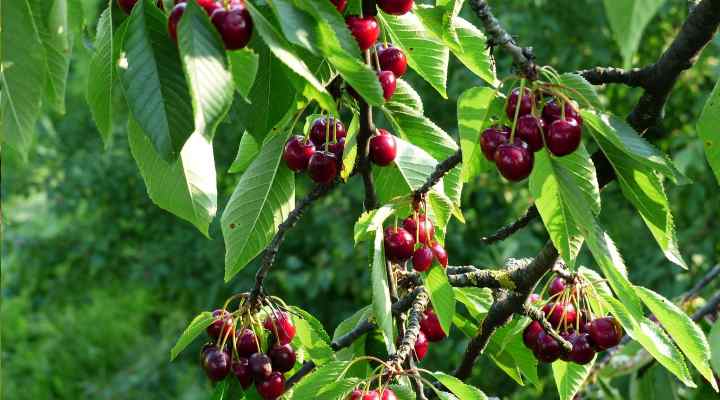
Purple cherries are a unique and flavorful variety of reddish-purple fleshy drupes. These cherries have deep purple to red skins and sweet, juicy flesh surrounding a large stone. The deep red to dark purple fruits mature in mid-summer after the beautiful white cherry blossoms have finished blooming.
The purple stone fruits have a rich, complex taste, both tart and sweet. They measure 0.5” to 0.75” (1 – 2 cm) in diameter and grow in small clusters among the foliage. In addition to their delicious red-purple fruits, cherry trees are prized for their spectacular spring floral displays.
Purple cherries are often used in culinary applications, such as pies, jams, and desserts. They can also be enjoyed fresh as a healthy snack. These cherries are packed with vitamins, minerals, and antioxidants, making them a nutritious addition to any diet. Additionally, they are low in calories and high in fiber, making them a great choice for those looking to maintain a healthy lifestyle.
Purple cherries are typically in season during summer. They are versatile fruits enjoyed in various culinary applications. They’re perfect for making jams, preserves, and cherry pies. Their rich color and sweet-tart flavor make them a delightful addition to salads, sauces, and beverages.
Blueberries (Vaccinium corymbosum)

Blueberries are small, round berries that are typically blue or purple-black in color. The small, round, bluish-purple fruits have a balanced taste of sweetness and mild tartness. Blueberries are juicy and refreshing, and their plump texture creates a burst of freshness for savory and sweet dishes.
Here are descriptions of types of purple blueberry fruits on three common varieties in North America:
Highbush blueberry (Vaccinium corymbosum): Growing up to 6 ft. (2.4 m) tall, the shrub produces clusters of plump, deep purple fruits with a perfect blend of sweetness and tartness.
Lowbush blueberry (Vaccinium angustifolium): This low-growing shrub produces small, sweet purple-colored berries on sprawling bushes.
Rabbiteye blueberry (Vaccinium ashei): Native to the Southeastern U.S., this blueberry variety has small, round bluish-purple berries with thick skins. They are not as flavorsome as other blueberry varieties.
Bilberries (Vaccinium myrtillus)
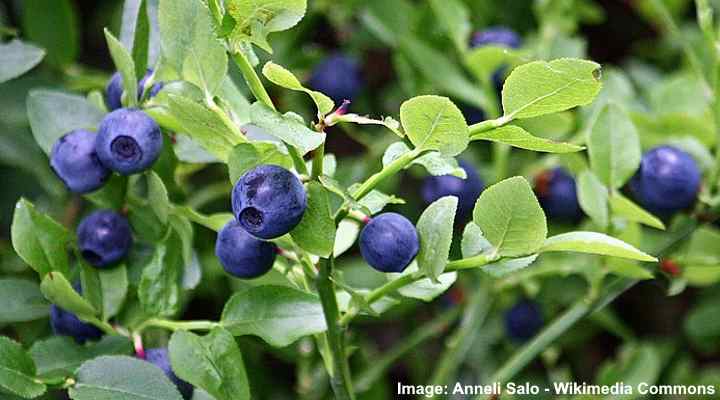
Bilberries are small, dark blue or purple berries that grow on small woodland shrubs under two feet tall (0.6 m). Native to Europe, bilberries are exceedingly sweet with slightly tart overtones. The small size of the berries intensifies their flavor. The purple berries measure about 0.19” to 0.39” (0.5 – 1 cm) in diameter.
Like blueberries, bilberry fruits have a variety of culinary uses. They are popular in cakes, muffins, and other baked goods. Additionally, you can eat them fresh, add them to desserts, or incorporate them into smoothies to enhance their nutritional content. You can also sprinkle the berries on yogurt or ice cream to add a splash of vibrant color and a burst of flavor.
According to studies, the purple fruits of Vaccinium shrubs are one of the richest sources of anthocyanins—vital antioxidants.
Boysenberry (Rubus ursinus x idaeus)

Boysenberry is a delicious and juicy reddish-purple fruit native to North America. The aggregate fruit is a cross between a raspberry, blackberry, dewberry, and loganberry. The large berries start bright red and gradually darken to purple as they mature. These fruits have a sweet and tangy flavor reminiscent of wild blackberries.
Boysenberries have a soft texture and are easier to pick than blackberries. They grow on thornless canes, meaning there is little risk of injury when harvesting them. Their juicy, soft flesh is perfect for eating fresh or using in various culinary applications.
Unfortunately, finding boysenberries in stores is nearly impossible. The soft, juicy berries have a short shelf life and are impossible to grow commercially. Therefore, if you want to enjoy these large, sweet, nutritious reddish-purple berries, you’ll have to grow the shrubs in your garden.
Saskatoon Berry (Amelanchier alnifolia)
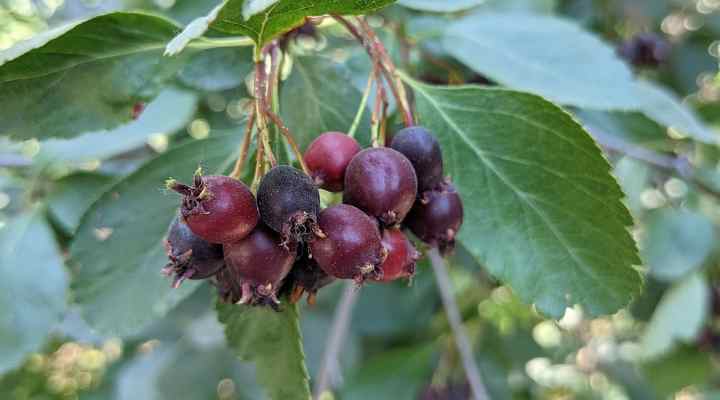
Saskatoon berries are small, dark purple pomes fruits resembling blueberries. The ornamental shrubs produce clusters of round reddish-purple fruits 0.5” (1.3 cm) in diameter. Apart from its small purple fruit, the attractive shrubs bloom in spring with showy white flowers, contrasting with green oval leaves.
Purple Saskatoon berries have a taste like a mix of blueberries or cherries and almonds. The sweet, nutty flavors enhance the texture, color, and flavor of several foods, including pies, jams, and desserts. In their native Canada, Saskatoon berries are used in preparing dried meat.
Like all purple berries, Saskatoon berries are also packed with nutritional benefits. They are a good source of fiber, vitamin C, and antioxidants, which can help promote overall health and well-being. They are also low in calories and fat, making them a healthy snack.
Other names for Saskatoon berries include western serviceberry, western juneberry, and Pacific serviceberry.
Sloe Berry (Prunus spinosa)
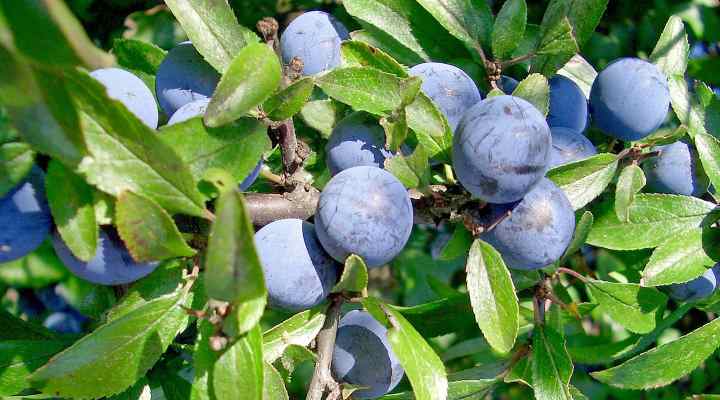
Sloe berries—or blackthorn berries—are small bluish-purple drupes. The fruits measure up to 0.5” (1.3 cm) in diameter and are black with a purplish waxy cover. Raw sloe berries have a bitter, tart, and earthy taste. Therefore, common uses for the purple fruits are making foods like desserts and pies or alcoholic beverages, like sloe gin and other liqueurs.
Purple sloe berries grown on thorny bushes up to 16 ft. (5 m) tall. Before the sour blueberry-like fruits appear, the shrub blooms in spring with masses of creamy-white blossoms, brightening landscapes. The shrub’s thorny nature is ideal as an informal privacy hedge or security barrier.
The tart, astringent flavor of sloe berries means they are versatile purple fruits for sweet and savory dishes. You can sweeten them to make preserves, jellies, and jams. Also, their distinct tartness imparts a unique flavor to stews, sauces, and game dishes.
Tayberry (Rubus fruticosus x idaeus)
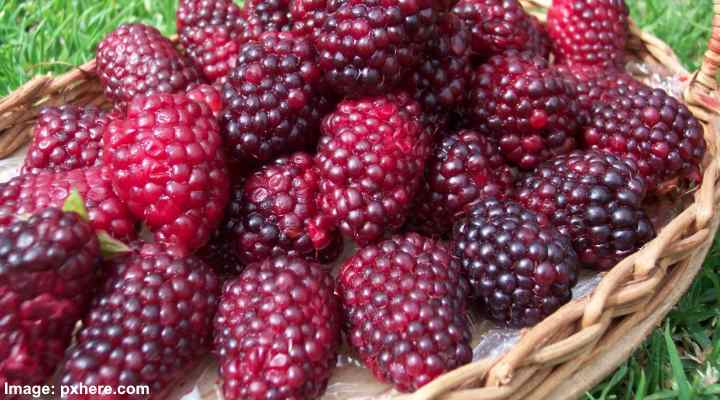
Tayberry is a purple fruit that looks like a cross between a blackberry and a raspberry. The large, elongated, dark reddish-purple berry has a distinct cone shape when ripe. Tayberries measure up to 1.5” (4 cm) long and grow like blackberries on prickly canes. The best berry production occurs when growing in direct sunlight.
The tayberry plant is a vigorous fruiting shrub that grows up to 7 ft. (2.1 m) tall. Its fruits are dark red to purple in color. The purplish fruits have a unique, complex flavor. They combine the sweetness of raspberries with the tartness of blackberries. The purple fruits are ready for harvesting in summer.
Like all types of purple berries, tayberries are rich in vitamins, micronutrients, and antioxidants. You can enjoy their distinct flavor fresh or add the fruits to fruit salads, smoothies, jams, pies, or baked products. Their vibrant color adds a beautiful touch to desserts.
American Elderberry (Sambucus canadensis)
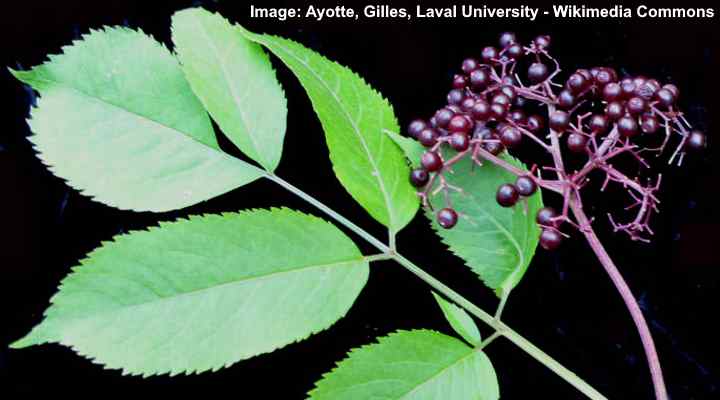
American elderberry is a small, dark, purplish-black berry growing in large, drooping clusters on elderberry shrubs. The small, round, edible fruits measure 0.25” (0.6 cm) in diameter and appear in the fall. They have a slightly bitter flavor but are sweeter than European elderberry fruits.
American elderberry dark purple fruits are commonly used for making wine, jams, and jellies. Their tart taste with earthy undertones goes well with allspice, clove, and cinnamon. The tasty berries add delicious flavors to fruit pies and other desserts.
It’s important to note that elderberries must be cooked before consumption. This is because raw elderberry fruits contain toxic compounds. However, cooking breaks down this compound, making the purple-black berries safe to eat.
Açai Berry (Euterpe oleracea)

Açai berry is a small, round, black-purple drupe fruit that grows on açai palm trees. The berries resemble dark purple grapes growing in huge clusters of 500 to 900 berries. The pulpy flesh surrounds a stone, and the flesh only makes up 20 to 40 percent of the fruit.
Açai berries have a unique flavor, described as a mix of berries, red wine, and dark chocolate. The berry’s flesh is soft and creamy; however, they are typically sold in their dried form and are added to smoothies, desserts, and stews as a ‘superfood.’
Açai berries are also sold in dried and powder form to make it easier to benefit from their nutritional value. Although consuming the dark purple berries has a reputation for helping a range of health issues, scientists say there is “no definitive scientific evidence based on studies in people to support the use of acai for any health-related purpose.”
Jabuticaba / Jaboticaba (Plinia cauliflora)
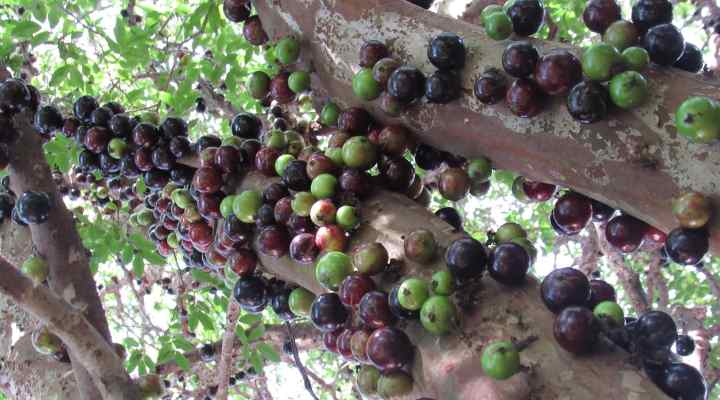
Jabuticaba is a unique, exotic fruit with shiny, purplish-black skins and white pulpy flesh. The slow-growing evergreen Brazilian grapetree produces thick-skinned round berries up to 1.6” (4 cm) in diameter. A distinctive feature of jabuticaba fruit trees is that the fruit appears directly on its trunk and branches.
The jabuticaba fruit is small, round, and dark purple, resembling a grape. It has a thick, leathery skin with a tart taste that is easily peeled. The fruit’s flesh is sweet and juicy. The flavor of jabuticaba is often described as a mix of Muscadine grapes, lychees, and plums.
Jabuticaba trees are relatively small, growing 50 ft. (15 m) tall. The fruit trees are recognized by their dense foliage, attractive, shiny leaves, and purple berries growing directly on the tree. The tree’s fibrous roots make it ideal for growing in containers in temperate and subtropical climates.
The tropical blackish-purple berries have a short shelf life. Therefore, they are common ingredients for making tarts, fortified wines, jams, and liqueurs. It’s impossible to find jabuticaba berries in specialty fruit stores outside of their cultivation area.
Maqui Berries (Aristotelia chilensis)
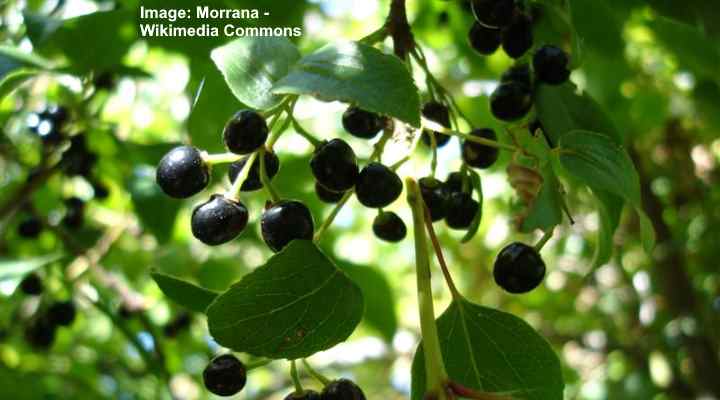
Maqui berries are small very dark purple-black tropical berries that taste like blackberries. Also called the Chilean wineberry, the shiny dark purple or black berries measure 0.16” to 0.24” (0.4 – 0.6 cm) in diameter. The edible blackish-purple fruits are common in gardens in South America, especially in the Andes Mountains.
Maqui berries have many uses as delicious dark purple fruits. You can eat the seed-containing berries straight off the tree. The berries are also popular in juices, jams, desserts, and smoothies. Their dark color and unique flavor give foods a unique taste and nutritional profile.
The delicious berries are also sold as diet supplements, including capsules, extracts, and powders. As with all purple fruits, the berries are rich in vitamin C and antioxidants. However, there is no scientific evidence for their reported health benefits.
Huckleberry (Vaccinium ovatum)
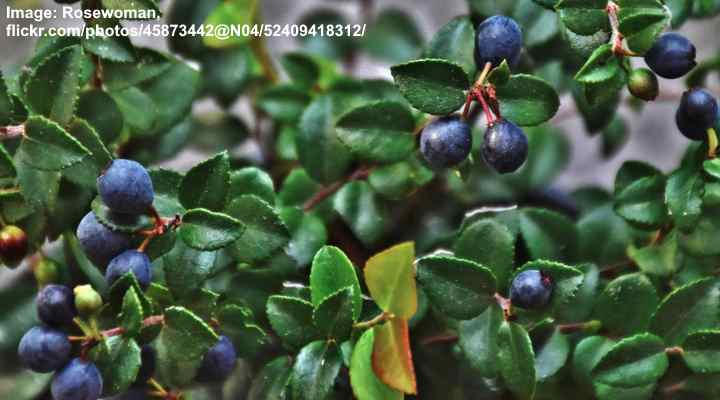
Fruits from the huckleberry shrub are small, round, dark purple to black berries native to the Pacific Northwest. The flowering shrub produces whitish-pink flowers, shiny berries, and waxy leaves on reddish stems. The leaves develop a reddish shade in full sun, and the shiny berries become almost black.
Huckleberry fruits have a sweet and tart flavor with hints of earthiness. The purple fruits taste like blueberries but have an intense, sweeter flavor. The low, spreading shrubs that can reach heights grow up to 10 ft. (3 m) tall, and the berries measure 0.4” (1 cm) in diameter.
The edible dark purple berries grow and mature on the attractive shrub during summer and fall. Purple huckleberries have a tart taste due to their high content of phenolic acids, resulting in a pH of around 2.6. Due to their sourness, the berries are ideal for making sweetened jellies, jams, and syrups.
Related articles:
